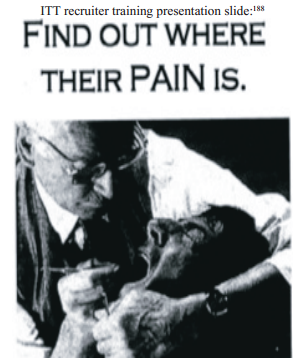Abstact:
For-profit universities have made millions of dollars in revenue by targeting vulnerable, low-income and minority populations. With deceptive tactics for-profit recruitment personnel pressure students into enrollment. Recruiters, however, are pressed to act ruthless by their own administrators. A hierarchy of intimidation
is created in which for-profit directors press employees to relentlessly target and take advantage of low-income and inner city students. Low-income students are left repaying debt to the for profit companies for the rest of their lives, oppressed into a life of poverty and limited social movement.
Work Cited
Cellini, Stephanie R. "Financial Aid and For-Profit Colleges: Does Aid Encourage Entry?" Journal of Policy Analysis and Management, 29.3 (2010): 526-52. Wiley Online Library. 7 June 2010. Web.
College, Inc. FRONTLINE. PBS, 2010. Online Program.
Gibson, Robert A. "Booker T. Washington and W. E. B. DuBois: The Problem of Negro Leadership." Yale-New Haven Teachers Institute 2 (1978): n. pag. Yale-New Haven Teachers Institute. Web. 09 Dec. 2012. <http://www.yale.edu/ynhti/curriculum/units/1978/2/78.02.02.x.html>.
Giroux, Henry A. "Neoliberalism, Corporate Culture, and the Promise of Higher Education: The University as a Democratic Public Sphere." Harvard Educational Review Vol. 72 No. 4 (2002): 426-463. Print
Kinser, Kevin. "Access in U.S. Higher Education: What Does the For-Profit Sector Contribute? ." Program for Research on Private Higher Education. University at Albany, State University of New York, Mar. 2009. Web. 07 Dec. 2012.
Roderick, Melissa, Jenny Nagaoka, and Vanessa Coca. "College Readiness for All: The Challenge for Urban High Schools." Future Of Children 19.1 (2009): 185-210. Print.
Williams, Jeffrey. "Academic Freedom and Indentured Students." Academic Freedom and Indentured Students 98.1 (2012): AAUP:. Web. 08 Dec. 2012.
U.S. Congress. Government Accountability Office. Postsecondary Education: Student Outcomes Vary at For-Profit, Nonprofit, and Public Schools. (1-91) Washington: Government Printing Office, Dec. 2011.
U.S. Congress. Government Accountability Office. FOR-PROFIT COLLEGES: Undercover Testing Finds Colleges Encouraged Fraud and Engaged in Deceptive and Questionable Marketing Practices. (1-27) Washington: Government Printing Office, Aug. 2010.
U.S. Senate. HEALTH, EDUCATION, LABOR AND PENSIONS COMMITTEE. For Profit Higher Education: The Failure to Safeguard the Federal Investment and Ensure Student Success (1-181). Washington: Government Printing Office, July. 2012
U.S. Senate. HEALTH, EDUCATION, LABOR AND PENSIONS COMMITTEE. For Profit Higher Education: The Failure to Safeguard the Federal Investment and Ensure Student Success PART II: Profiles of 30 For-Profit Education Companies (202-720). Washington: Government Printing Office, July. 2012


